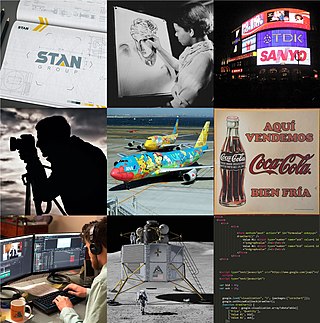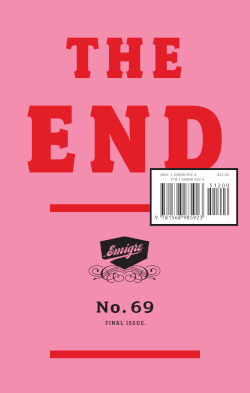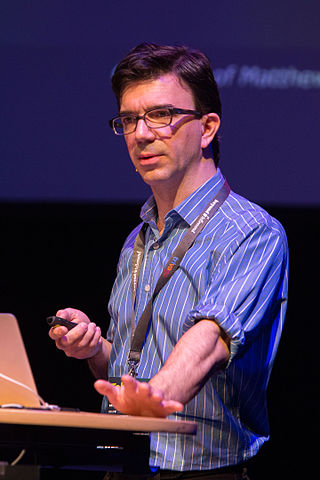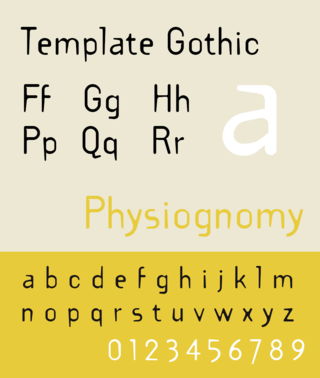
Graphic design is a profession, academic discipline and applied art whose activity consists in projecting visual communications intended to transmit specific messages to social groups, with specific objectives. Graphic design is an interdisciplinary branch of design and of the fine arts. Its practice involves creativity, innovation and lateral thinking using manual or digital tools, where it is usual to use text and graphics to communicate visually.

Emigre, Inc., doing business as Emigre Fonts, is a digital type foundry based in Berkeley, California, that was founded in 1985 by husband-and-wife team Rudy VanderLans and Zuzana Licko. The type foundry grew out of Emigre magazine, a publication founded by VanderLans and two Dutch friends who met in San Francisco, CA in 1984. Note that unlike the word émigré, Emigre is officially spelled without accents.

Emigre was a (mostly) quarterly magazine published from 1984 until 2005 in Berkeley, California, dedicated to visual communication, graphic design, typography, and design criticism. Produced by Rudy VanderLans and Zuzana Licko, Emigre was known for creating some of the first digital layouts and typeface designs. Exposure to Licko's typefaces through the magazine lead to the creation of Emigre Fonts in 1985.

Milton Glaser was an American graphic designer, recognized for his designs, including the I Love New York logo; a 1966 poster for Bob Dylan; the logos for DC Comics, Stony Brook University, Brooklyn Brewery; and his graphic work on the introduction of the iconic 1969 Olivetti Valentine typewriter.
Zuzana Licko is a Slovak-born American type designer and visual artist known for co-founding Emigre Fonts, a digital type foundry in Berkeley, CA. She has designed and produced numerous digital typefaces including the popular Mrs Eaves, Modula, Filosofia, and Matrix. As a corresponding interest she also creates ceramic sculptures and jacquard weavings.

Neville Brody, is an English graphic designer, typographer and art director. He is known for his work on The Face magazine (1981–1986), Arena magazine (1987–1990), and designing record covers for artists such as Clock DVA, Cabaret Voltaire, The Bongos, 23 Skidoo and Depeche Mode. He created the company Research Studios in 1994 and is a founding member of Fontworks. His work is included in the permanent collection of the Museum of Modern Art (MoMA). He was the Dean of the School of Communication at the Royal College of Art, London until September 2018. He is now Professor of Communication.
Rudy VanderLans is a Dutch graphic designer, photographer, and the co-founder of Emigre Fonts with his wife Zuzana Licko. Emigre Fonts is an independent type foundry in Berkeley, CA. He was also the art director and editor of Emigre magazine, the journal devoted to visual communications from 1984 to 2005. Since arriving in California in 1981, he has been photographing his adoptive Golden State as an ongoing side project. He has authored a total of 11 photo books on the topic, and staged two solo exhibits at Gallery 16 in San Francisco.

Tobias Frere-Jones is an American type designer who works in New York City. He operates the company Frere-Jones Type and teaches typeface design at the Yale School of Art MFA program.

Peter Biľak is a Slovak graphics and typeface designer based in The Hague, Netherlands. He works in the editorial, graphic, and type design fields.

Herbert Matter was a Swiss-born American photographer and graphic designer known for his pioneering use of photomontage in commercial art. Matter's innovative and experimental work helped shape the vocabulary of 20th-century graphic design.
Paul Scott Makela was a graphic designer, multimedia designer and type designer. Among other work, he was especially noted for the design of Dead History, a postmodern typeface that combined features of a rounded sans serif typeface and a crisp neo-classical serif typeface. With the emergence of the personal computer in the mid-1980s, Makela was among the first to explore digital programs such as Photoshop and Adobe Illustrator. As a result, he created an idiosyncratic, original and highly controversial design aesthetic. In particular, his disregard for clean, modernist, problem-solving design agendas—synonymous with contemporary corporate graphic design—caused much debate among powerful, old-guard designers such as Massimo Vignelli, Paul Rand, and Henry Wolf.
Lorraine Wild is a Canadian-born American graphic designer, writer, art historian, and teacher. She is an AIGA Medalist and principal of Green Dragon Office, a design firm that focuses on collaborative work with artists, architects, curators, editors and publishers. Wild is based in Los Angeles, California.
Edward Fella is an American graphic designer, artist and educator. He created the OutWest typeface in 1993. His work is held in the collection of the Cooper-Hewitt, National Design Museum, the Brauer Museum of Art, and the Museum of Modern Art. He was the recipient of the 2007 AIGA Medal. He was also the recipient of a Chrysler Award in 1997. Curt Cloninger called Fella "the contemporary master of hand-drawn typography."
Jeffery Keedy, born 1957, is an American graphic designer, type designer, writer and educator. He is notable as an essayist and contributor to books and periodicals on graphic design. He is also notable for the design of Keedy Sans, a typeface acquired in the permanent collection of the Museum of Modern Art in 2011.

Jonathan Barnbrook is a British graphic designer, film maker and typographer. He trained at Saint Martin's School of Art and at the Royal College of Art, both in London.
Katherine McCoy is an American graphic designer and educator, best known for her work as the co-chair of the graduate Design program for Cranbrook Academy of Art.
Andrew Blauvelt is a Japanese-American curator, designer, educator, and writer. Since 2015 he has served as director of the Cranbrook Art Museum in Bloomfield Hills, Michigan.

Template Gothic is an experimental, sans-serif typeface designed by Barry Deck in 1989. It was not commercially released until type designer Rudy VanderLans was exposed to the font, when Deck's California Institute of the Arts graduate class visited his studio. In 1991, it was released by Emigre, a type foundry, of which VanderLans was a co-founder. In 1992, Deck developed a serif variation of the font.
Nicole Marie Killian is a new media artist and design educator based in Richmond, Virginia.
Laurie Haycock Makela is an American graphic designer and educator. She co-chaired the design program at Cranbrook Academy of Art in the 1990s along with her husband, P. Scott Makela. Both were honored with the AIGA medal in 2000.










